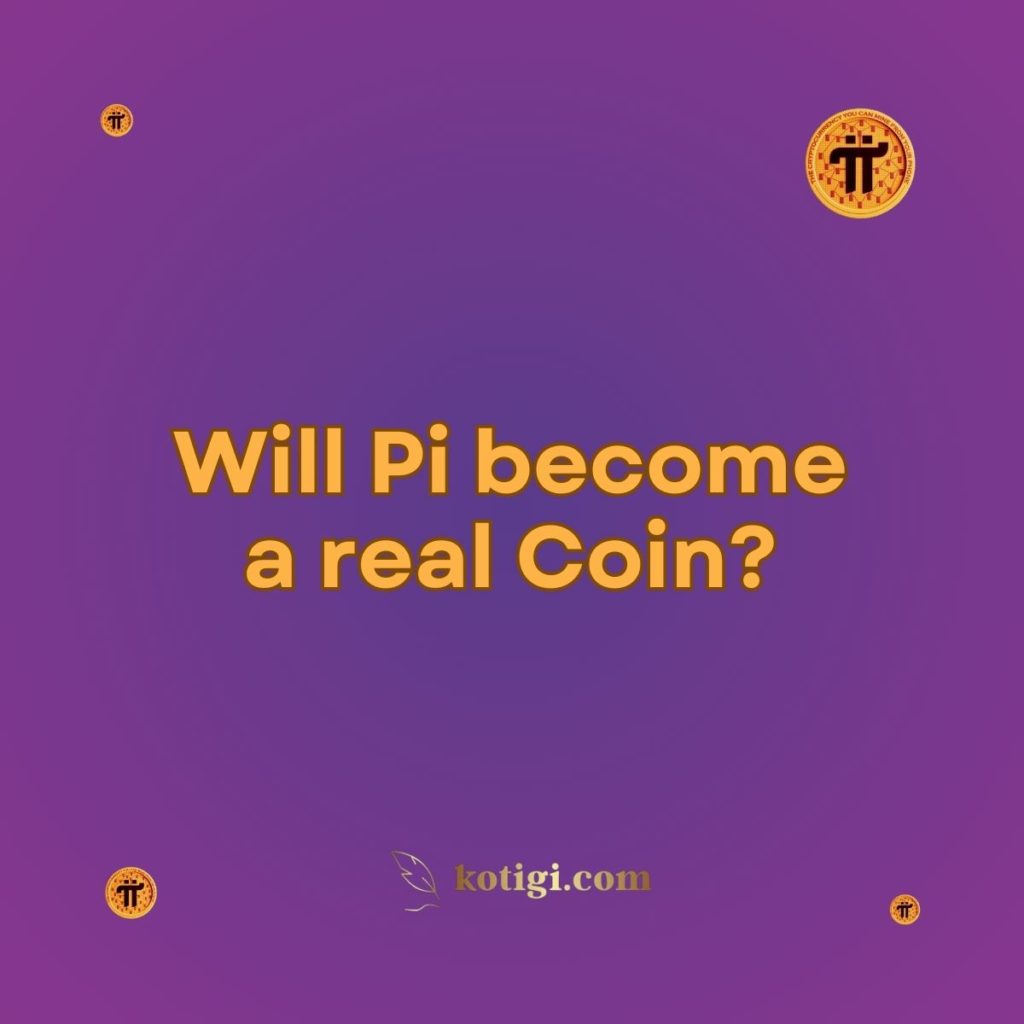
The Pi Network has generated significant interest since its inception, with millions of users mining Pi coins through their smartphones. However, a common question that arises is whether Pi will become a real, tradable coin like Bitcoin, Ethereum, and other established cryptocurrencies. In this article, we’ll explore the factors that will determine if Pi can transition into a real coin with real value on cryptocurrency exchanges.
Will Pi become a real Coin?
Pi Network is currently in its enclosed mainnet phase, and the Pi coin is not yet traded on cryptocurrency exchanges. Whether Pi will become a “real” coin, meaning it can be traded, bought, and sold in open markets, depends on the project’s future development, its mainnet launch, and the establishment of a functional ecosystem with real-world use cases.
What is Pi Network’s Current Status?
Pi’s Enclosed Mainnet
As of now, Pi Network operates within an enclosed mainnet. This means that Pi coins can be mined by users, but they cannot be traded on cryptocurrency exchanges. The enclosed mainnet allows the Pi team to continue developing the ecosystem and working on security features without external interference. Users can only transfer Pi within the network for limited transactions, but there is no official market value for the coin.
Mainnet Launch and Its Importance
Pi’s transition to an open mainnet will be a critical milestone. Once the network shifts to an open mainnet, Pi will be listed on cryptocurrency exchanges, enabling users to trade Pi coins for fiat currencies or other cryptocurrencies. The open mainnet will also enable Pi’s price to be determined by supply and demand in the market, just like any other coin.
Current Utility of Pi
At this point, Pi’s utility is limited to the Pi ecosystem, where users can mine coins and participate in the network. While there are promises of future decentralized applications (dApps) and marketplaces where Pi can be used, these developments are still in progress. For Pi to become a “real” coin in the broader sense, it needs to establish utility beyond its enclosed network.
What is Required for Pi to Become a Tradable Coin?
Transition to Open Mainnet
The most important factor in Pi becoming a real coin is the transition to the open mainnet. Once Pi is launched on the open mainnet, it will be listed on exchanges, allowing the market to assign a value to the coin based on demand. This transition will likely depend on the completion of Pi’s ecosystem development, security enhancements, and compliance with regulatory standards.
Exchange Listings
To become a real coin, Pi needs to be listed on popular cryptocurrency exchanges like Binance, Coinbase, or Kraken. These exchanges facilitate the buying, selling, and trading of cryptocurrencies. The Pi team has stated that they plan to list Pi on exchanges once the open mainnet launches, but the timeline for this is not yet confirmed. Listings on reputable exchanges will provide liquidity to Pi and make it more accessible to a broader audience.
Market Demand and Adoption
For Pi to gain real value, there needs to be demand for the coin in the open market. Demand will likely come from three areas:
- Speculators looking to trade Pi for profit.
- Users who see potential in the Pi ecosystem.
- Businesses that might accept Pi as a form of payment.
Without demand, even a tradable Pi coin might struggle to gain value in the marketplace. For demand to grow, Pi will need to prove its utility, security, and scalability.
Will Pi Have Real-World Use Cases?
Building the Pi Ecosystem
A critical component of Pi’s success as a real coin is the development of a robust ecosystem that allows users to spend Pi for goods and services. The Pi Network team has discussed plans to create a decentralized platform where developers can build dApps and merchants can accept Pi payments. These real-world use cases will be essential in establishing Pi’s value and driving adoption beyond just mining.
Partnerships and Merchant Adoption
For Pi to gain widespread use, partnerships with businesses and merchants will be crucial. If Pi is accepted by online retailers or service providers as a form of payment, its value could rise. The challenge for Pi will be convincing businesses to accept the currency in its early stages, especially when its value is still undetermined.
Potential Challenges
Pi faces several challenges in becoming a coin with real-world use:
- Regulation: Pi, like other cryptocurrencies, will need to navigate complex and evolving regulatory frameworks worldwide. If Pi does not meet regulatory requirements, it could face limitations in adoption and use.
- Competition: The cryptocurrency market is already crowded with thousands of coins. Pi will need to differentiate itself by offering unique features or solving real-world problems to stand out.
- Security Concerns: As Pi transitions to the open mainnet, ensuring the security of its blockchain will be paramount. Any security vulnerabilities could impact its credibility and market value.
What Factors Will Influence Pi’s Future Value?
Supply and Demand
Like all cryptocurrencies, Pi’s value will ultimately be determined by supply and demand. While the total supply of Pi is not yet finalized, the network’s mining rewards will decrease over time, potentially limiting the supply of new coins. On the demand side, factors such as user adoption, utility, and speculation will play a critical role in driving the coin’s price once it is listed on exchanges.
Speculation and Market Sentiment
In the early stages of Pi’s open mainnet, its price may be highly influenced by speculation. Early adopters and investors might rush to buy or sell Pi, leading to high volatility in its price. Over time, as Pi’s ecosystem develops and real use cases emerge, its value could stabilize based on more tangible factors like adoption and utility.
Long-Term Utility
For Pi to maintain and grow its value over the long term, it will need to provide long-term utility. This could include functioning as a means of payment, supporting decentralized applications, or enabling smart contracts. If Pi can deliver on these promises, it may gain a solid foothold in the broader cryptocurrency market.
Conclusion
Pi Network has the potential to become a real coin once it transitions to an open mainnet and is listed on cryptocurrency exchanges. However, its success will depend on several key factors, including exchange listings, market demand, and the development of a functional ecosystem. While Pi has attracted millions of users through its mobile mining app, it still has a long way to go before achieving the status of a widely accepted and tradable cryptocurrency. The path to becoming a real coin will involve overcoming regulatory, security, and adoption challenges, but the project’s potential is undeniable.
Key Takeaways:
- Pi Network is currently in an enclosed mainnet phase and is not yet tradable on exchanges.
- The transition to an open mainnet is essential for Pi to become a real coin with a market-determined value.
- Exchange listings, market demand, and real-world use cases will be critical to Pi’s success as a tradable coin.
- Pi faces challenges related to regulation, competition, and security, but it has the potential to create a functional ecosystem that could support its value.
- The future value of Pi will depend on supply and demand dynamics, as well as the long-term utility of the coin.





